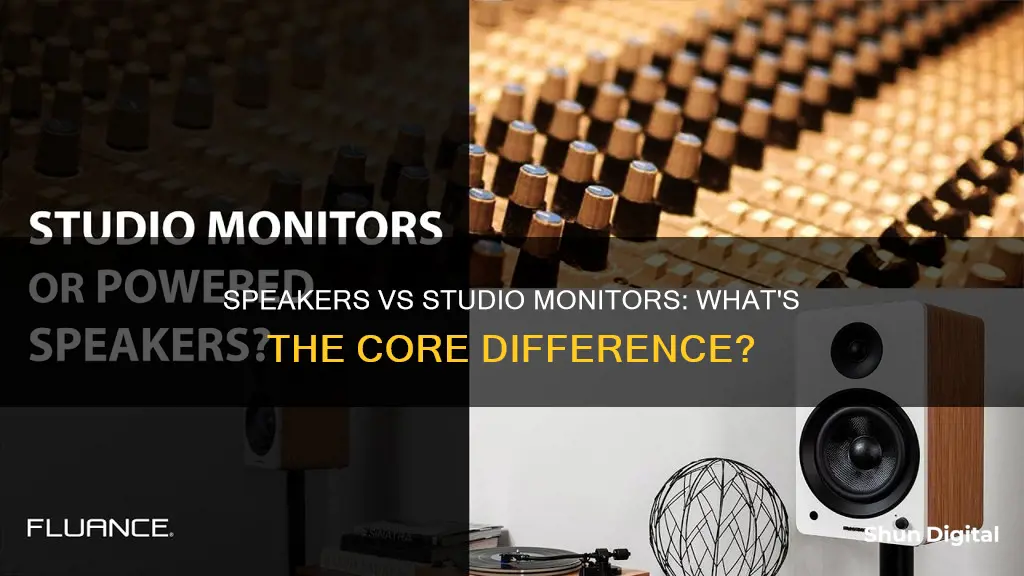
Studio monitors and speakers may look similar, but they are designed for different purposes. Studio monitors are used for recording, mixing, and mastering audio. They are designed to have a flat, precise sound, which means they do not emphasise any one frequency. This allows producers to pick out sonic imperfections and fix them. Studio monitors are also designed for nearfield use, meaning they are intended to be used a few feet away from the listener, providing a clear and immediate sound. On the other hand, speakers are designed for the best listening experience. They are typically used in living rooms and are designed to fill the room with sound. Speakers often have a predetermined frequency setting built into them to distort or amplify certain sounds, changing the way a sound is heard.
| Characteristics | Values |
|---|---|
| Purpose | Studio monitors are used for production aspects of audio products, whereas regular speakers are used for the consumption of audio products. |
| Sound | Studio monitors are designed to have a flat, precise sound for nearfield use. Regular speakers are designed to amplify or change the amplitude of the sound wave. |
| Use case | Studio monitors are used for critical listening, recording, mixing, mastering, and editing. Regular speakers are used for casual listening and entertainment. |
| Active/passive | Studio monitors are active speakers with built-in power amplifiers. Regular speakers are generally passive, receiving power from a dedicated standalone amplifier. |
| Individual power amplifiers | Studio monitors have multiple power amplifiers in one unit, powering each cone individually. |
| Crossovers | Studio monitors have crossovers that split frequencies to ensure they go to the right driver. |
| Projection | Studio monitors are designed for short distances and small areas. Regular speakers are designed to project sound throughout a room. |
| Cost | Studio monitors are more expensive due to intricate engineering and premium components. |
What You'll Learn
- Studio monitors are designed for critical listening, while regular speakers are for entertainment
- Studio monitors are active speakers, meaning they have built-in amplifiers
- Studio monitors are intended for nearfield use, focusing audio waves on a smaller field
- Studio monitors aim for a flat frequency response, while regular speakers have a predetermined frequency setting
- Studio monitors are more expensive due to intricate engineering and premium components

Studio monitors are designed for critical listening, while regular speakers are for entertainment
Studio monitors and regular speakers may look similar, but they are designed for different purposes and behave differently. Studio monitors are designed for critical listening, while regular speakers are for entertainment.
Studio monitors are used in the recording, mixing, and mastering process. They are designed to reproduce audio in a transparent and neutral manner, presenting the true nature of the recordings. They are meant to sound \"bad\" so that sonic imperfections can be identified and fixed. Studio monitors have a flat frequency response, meaning they do not amplify any frequencies such as bass or treble. They are also active speakers, with built-in amplifiers, allowing manufacturers to have greater control over the audio signal path and providing a cohesive, integrated audio system.
Regular speakers, on the other hand, are designed for entertainment and listening pleasure. They often use frequency manipulation to enhance the listening experience. They have a predetermined frequency setting built into them to distort or amplify certain sounds, changing the way a sound is heard. Regular speakers are designed to project sound over larger areas and are optimal for room-filling audio.
In terms of projection, studio monitors are crafted for short distances and are ideal for bedrooms, studios, and smaller areas. Regular speakers, on the other hand, are designed to project sound throughout a room and are better suited for living rooms, dens, or outdoor areas.
Studio monitors are also more expensive than regular speakers due to their intricate engineering, premium components, and rigorous quality control measures. They are geared towards professionals and may not be as accessible to regular music lovers.
In summary, studio monitors are designed for critical listening and music production, while regular speakers are designed for entertainment and listening pleasure. Studio monitors provide a transparent, neutral, and accurate representation of the audio signal, while regular speakers enhance the listening experience by manipulating frequencies.
Monitoring Container Performance with Kibana: A Comprehensive Guide
You may want to see also

Studio monitors are active speakers, meaning they have built-in amplifiers
The active configuration of studio monitors also enables individual power amplification for each driver (woofer, midrange, and tweeter). This means that each component of the speaker can be powered individually, resulting in a more precise sound. Additionally, studio monitors often utilise multiple amplifiers in a single unit, further enhancing the sound precision. This individual amplification of different frequency ranges ensures that each part of the audio spectrum is accurately reproduced without any colouration or enhancement.
The built-in amplifiers in studio monitors contribute to their ability to provide a flat, precise, and unadulterated sound. Unlike regular speakers, which often use frequency manipulation to enhance the listening experience, studio monitors aim for transparency and neutrality. They are designed for critical listening, allowing engineers and producers to detect even the slightest nuances and imperfections in their recordings. The flat frequency response of studio monitors ensures that no single frequency is emphasised, providing an accurate impression of the mix.
The active nature of studio monitors, with their built-in amplifiers, also contributes to their versatility. They can be used in nearfield monitoring, where speakers are placed close to the listener, typically within arm's reach. This nearfield use reduces the impact of room acoustics and provides an immediate, upfront impression of the mix. Studio monitors are designed to focus audio waves in this nearfield, making them ideal for studio environments where precise, detailed sound reproduction is crucial.
In summary, the built-in amplifiers in studio monitors are a key factor in their functionality and performance. They enable precise, individual amplification of different frequency ranges, resulting in a flat and accurate sound. This active design enhances the versatility, efficiency, and fidelity of studio monitors, making them essential tools for professionals in audio production and critical listening applications.
Monitoring Watt Usage: Outlet Power Tracking
You may want to see also

Studio monitors are intended for nearfield use, focusing audio waves on a smaller field
Studio monitors are designed for nearfield use, meaning they are placed close to the user/listener, usually within arm's reach. This close proximity offers several advantages for audio professionals. Firstly, it ensures a clear and immediate sound, free from natural reverberations, providing a precise and upfront impression of the mix. This is crucial for critical listening and music production, as it allows for the identification of sonic imperfections that need to be fixed.
Secondly, nearfield use in studio monitors reduces the impact of room acoustics and other variables. This means that the listener can make critical decisions with confidence and accuracy, as the audio waves are focused on a smaller field, making it easier to maintain purity. Studio monitors are designed to be directional, with sound directed towards the listener's ears, minimising sound going into the room to reverberate. This design choice ensures that what the listener hears is closer to the actual recording.
The nearfield nature of studio monitors also means that the listening position is very specific and set, as sitting too far off-axis will dull the highs. This is in contrast to hi-fi speakers, which are typically used in living room setups by multiple people and are designed to have a wider sweet spot.
In summary, studio monitors are intended for nearfield use, focusing audio waves on a smaller field to facilitate critical listening, accurate evaluation, and precise decision-making in audio production.
Finding DisplayPort Connections on Monitors
You may want to see also

Studio monitors aim for a flat frequency response, while regular speakers have a predetermined frequency setting
Studio monitors are designed to reproduce audio transparently and neutrally, aiming for a flat frequency response. This means that they do not amplify orsection_break:large_break:unique_id:answer100
Distort any frequencies, such as bass or treble, in the sound wave. They are used for critical listening and analytical hearing, allowing producers and engineers to detect nuances and imperfections. In contrast, regular speakers often use frequency manipulation to enhance the listening experience, with predetermined frequency settings that amplify or distort certain sounds.
Studio monitors are active speakers with built-in amplifiers, allowing manufacturers greater control over the audio signal path, minimising signal degradation and optimising performance. They are designed for nearfield use, with speakers placed close to the listener, reducing the impact of room acoustics. This enables users to assess the finer details of their mixes with excellent clarity and accuracy. The active configuration also enables built-in signal processing capabilities, allowing for precise calibration and equalisation to achieve a flat frequency response.
Regular speakers, on the other hand, are typically passive, requiring an external amplifier to drive the audio signal. They are designed to provide entertainment and listening pleasure, often enhancing the sound with middle and high frequencies and rich bass. They are ideal for social gatherings, home audio, and home theatre listening, projecting sound to fill a room.
Studio monitors are designed for professionals in audio recording, mixing, and mastering, ensuring that the speakers do not influence the audio professional'ssection_break:large_break:unique_id:answer200
Editing decisions. They aim to maintain the 'true' frequencies of the audio, reproducing the source material accurately. Regular speakers, meanwhile, are designed for the best listening experience, with a focus on pleasure rather than analytical hearing. They are suitable for casual listening and entertainment purposes, often used in living rooms or by multiple people at once.
Ankle Monitors: Surveillance and Freedom in Question
You may want to see also

Studio monitors are more expensive due to intricate engineering and premium components
Studio monitors are designed to reproduce audio with accuracy, transparency, and neutrality. They are built for analytical hearing, allowing audio engineers to detect even the slightest nuances and imperfections in their recordings. This level of precision requires intricate engineering and premium components, which come at a higher cost.
Studio monitors differ from regular speakers in their internal architecture and amplification methodology. Studio monitors are typically active speakers, with built-in amplifiers, while regular speakers are usually passive, requiring an external amplifier. This active configuration gives studio monitor manufacturers greater control over the audio signal path, minimising signal degradation and optimising performance.
The components used in studio monitors are carefully selected and optimised to achieve sonic purity and accuracy. They are designed to reduce undesirable artifacts such as resonance, distortion, and phase anomalies, ensuring a transparent, uncolored sound signature. This level of precision requires premium components and meticulous craftsmanship, which increases the production cost.
Studio monitors also undergo rigorous testing and calibration processes to ensure they produce a flat, linear frequency response that covers the audible spectrum. This calibration process ensures that the monitors offer a cohesive, integrated audio system with utmost efficiency and fidelity. The intricate engineering and precise calibration of studio monitors contribute to their higher price point compared to conventional home stereo speakers.
In summary, the higher cost of studio monitors is justified by their intricate engineering, premium components, and rigorous quality control measures. These factors ensure that studio monitors deliver exceptional sound quality, making them indispensable tools for professional audio production and critical listening applications.
Blind Spot Monitor Standardization in Hyundai Santa Fe Models
You may want to see also
Frequently asked questions
Studio monitors and speakers are designed for different purposes and behaviours. Studio monitors are used for analytical hearing, allowing audio engineers to identify and fix any sonic imperfections. Speakers, on the other hand, are designed to provide an optimal listening experience. Studio monitors are typically used in recording, mixing, and mastering processes, while speakers are used for casual listening.
Studio monitors are typically active speakers, meaning they have built-in power amplifiers. Speakers, in contrast, are usually passive, requiring power from a separate amplifier. Studio monitors often have multiple power amplifiers in a single unit, powering the woofer, midrange, and tweeter individually for a more precise sound. Additionally, studio monitors aim for a flat frequency response, while speakers may enhance certain frequencies to improve the listening experience.
Studio monitors offer consistency and accurate reproduction of recorded material, making them ideal for critical listening, recording, and mixing applications. They are designed for short distances and small spaces, such as bedrooms and studios. However, they may not be as accessible to regular music lovers due to their pro-level intricacies and limited amplification options.
While speakers can be used for music production, studio monitors are generally recommended for a more accurate and reliable sound. Speakers may miss some details in the sound, leading to an imbalanced mix. Studio monitors provide a flat response, allowing you to easily identify and fix any issues in your mix.







